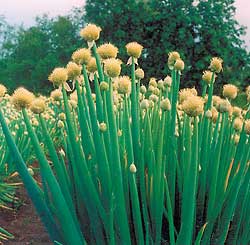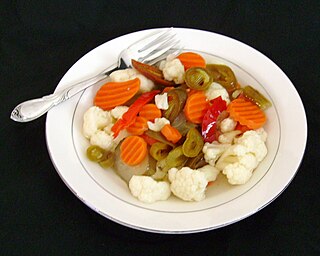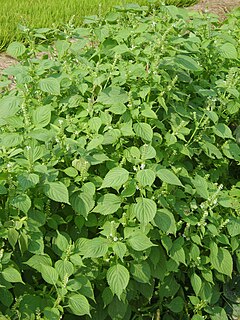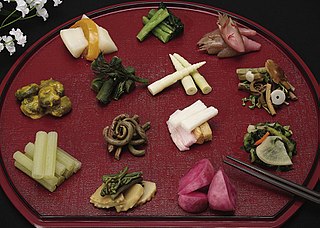
Aralia elata, the Japanese angelica tree, Chinese angelica-tree, or Korean angelica-tree, is a woody plant belonging to the family Araliaceae. It is known as tara-no-ki in Japanese, and dureup-namu (두릅나무) in Korean.

Allium fistulosum, the Welsh onion, also commonly called bunching onion, long green onion, Japanese bunching onion, and spring onion, is a species of perennial plant, often considered to be a kind of scallion.

Chayote, also known as mirliton, choko, tayota, chocho (Jamaica), and chuchu (Brazil), is an edible plant belonging to the gourd family, Cucurbitaceae. Chayote was one of the several foods introduced to the Old World during the Columbian Exchange. Also during this period, the plant spread from Mesoamerica to other parts of the Americas, ultimately causing it to be integrated into the cuisine of many other Latin American nations.

Samgyeopsal, samgyeopsal-gui (삼겹살구이), or grilled pork belly is a type of gui in Korean cuisine.

Giardiniera is an Italian relish of pickled vegetables in vinegar or oil.
Chwinamul (취나물) is a fragrant leaf vegetable with heart-shaped serrated leaves that grows in the mountains and fields of Korea. The word chwinamul in its strict sense refers only to chamchwi, literally translated as "true chwi". However, there are about a hundred varieties of chwinamul that grow naturally in Korea, including sixty-odd edible varieties. Among them, gomchwi, gaemichwi, miyeokchwi, surichwi, matari, and gaksichwi are the most eaten varieties.

Allium monanthum, the Korean wild chive, is a spring vegetable with minuscule bulbous roots that have a mild onion flavor and found in the woodlands of Korea, Japan, northeastern Russia (Primorye), and northeastern China.

Allium chinense is an edible species of Allium, native to China, and cultivated in many other countries. Its close relatives include the onion, shallot, leek, chive, and garlic.

Perilla frutescens, commonly called perilla or Korean perilla, is a species of Perilla in the mint family Lamiaceae. It is an annual plant native to Southeast Asia and Indian highlands, and is traditionally grown in the Korean peninsula, southern China, Japan and India as a crop.

Ligularia is a genus of Old World herbaceous perennial plants in the groundsel tribe within the sunflower family. They have yellow or orange composite flower heads with brown or yellow central disc florets, and are native to damp habitats mostly in central and eastern Asia, with a few species from Europe. There are about 120 to 140 species in the genus, and over half are endemic to China. The name Ligularia, from the Latin for "strap", refers to the shape of the ray florets.

Codonopsis lanceolata, also called deodeok or lance asiabell, is a flowering plant native to East Asia. It is a variety of bonnet bellflower.

Jangajji (장아찌) or pickled vegetables is a type of banchan made by pickling vegetables. Unlike kimchi, jangajji is non-fermented vegetables, usually pickled in soy sauce, soybean paste, or chili paste. Jangajji dishes are usually preserved for a long period of time, and served with a drizzle of sesame oil. Preserved foods like jangajji were developed to attain a certain level of vegetable consumption during the long, harsh winters on the Korean peninsula.

Saccharina japonica is a marine species of the Phaeophyceae plant, a type of kelp or seaweed, which is extensively cultivated on ropes between the seas of China, Japan and Korea. It is widely eaten in East Asia. A commercially important species, S. japonica is also called ma-konbu (真昆布) in Japanese, dasima (다시마) in Korean and hǎidài (海带) in Chinese. Large harvests are produced by rope cultivation which is a simple method of growing seaweeds by attaching them to floating ropes in the ocean.

Shishito pepper is a mildly spicy, East Asian variety of the species Capsicum annuum. It is known as kkwari-gochu in Korea because its wrinkled surface resembles groundcherries.

Zanthoxylum piperitum, also known as Japanese pepper, Japanese prickly-ash, or Korean pepper, is a deciduous aromatic spiny shrub or small tree of the citrus and rue family Rutaceae, native to Japan and Korea.

Mu or Korean radish is a variety of white radish with a firm crunchy texture.

Paocai is salted fermented vegetables. It is also known as pickle in the past, typically made using Chinese cabbage, mustard stems, long beans, peppers, daikon, carrots, and ginger. Pao Cai often found in Chinese, and particularly Sichuan cuisine. It is most commonly found in northern and western China; however, there is also a unique form of pao cai, called suan cai, which is prominent in Northeastern China. It is often eaten with congee as a breakfast food. Similar fermented vegetables can be found all over the world with various favors, such as the Sichuanese Zha cai, Korean Kimchi, Central American Curtido, French Cornichons, and the German Sauerkraut.

Tsukemono are Japanese preserved vegetables. They are served with rice as an okazu, with drinks as an otsumami (snack), as an accompaniment to or garnish for meals, and as a course in the kaiseki portion of a Japanese tea ceremony.

Gegeolmu, or gegeol radish, is a variety of white radish. It is a round, pungent radish with a thick rind and firm flesh that does not get soft even after a few years of storage as kimchi.



















